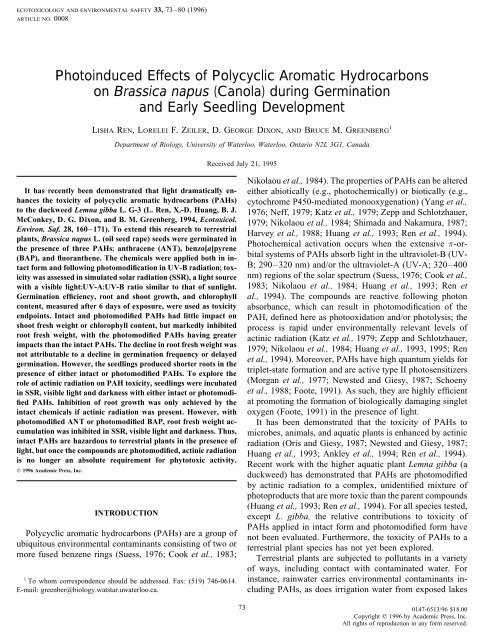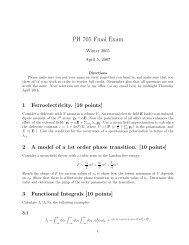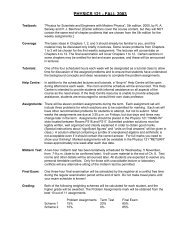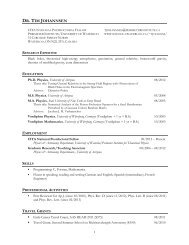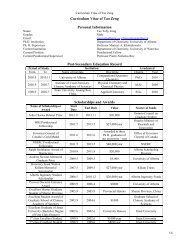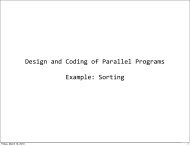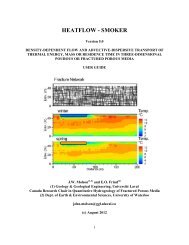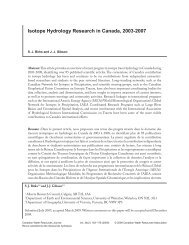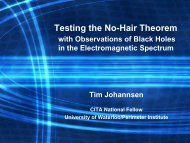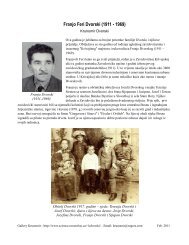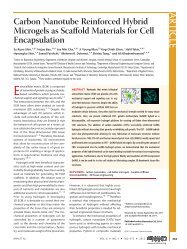45. Ren, L., Zeiler, L.F., Dixon, D.G. and Greenberg, B.M. 1996 ...
45. Ren, L., Zeiler, L.F., Dixon, D.G. and Greenberg, B.M. 1996 ...
45. Ren, L., Zeiler, L.F., Dixon, D.G. and Greenberg, B.M. 1996 ...
Create successful ePaper yourself
Turn your PDF publications into a flip-book with our unique Google optimized e-Paper software.
ECOTOXICOLOGY AND ENVIRONMENTAL SAFETY 33, 73–80 (<strong>1996</strong>)<br />
ARTICLE NO. 0008<br />
Photoinduced Effects of Polycyclic Aromatic Hydrocarbons<br />
on Brassica napus (Canola) during Germination<br />
<strong>and</strong> Early Seedling Development<br />
LISHA REN, LORELEI F. ZEILER, D.GEORGE DIXON, AND BRUCE M. GREENBERG 1<br />
Department of Biology, University of Waterloo, Waterloo, Ontario N2L 3G1, Canada<br />
Received July 21, 1995<br />
Nikolaou et al., 1984). The properties of PAHs can be altered<br />
It has recently been demonstrated that light dramatically en- either abiotically (e.g., photochemically) or biotically (e.g.,<br />
hances the toxicity of polycyclic aromatic hydrocarbons (PAHs) cytochrome P450-mediated monooxygenation) (Yang et al.,<br />
to the duckweed Lemna gibba L. G-3 (L. <strong>Ren</strong>, X.-D. Huang, B. J. 1976; Neff, 1979; Katz et al., 1979; Zepp <strong>and</strong> Schlotzhauer,<br />
McConkey, D. G. <strong>Dixon</strong>, <strong>and</strong> B. M. <strong>Greenberg</strong>, 1994, Ecotoxicol. 1979; Nikolaou et al., 1984; Shimada <strong>and</strong> Nakamura, 1987;<br />
Environ. Saf. 28, 160–171). To extend this research to terrestrial<br />
Harvey et al., 1988; Huang et al., 1993; <strong>Ren</strong> et al., 1994).<br />
plants, Brassica napus L. (oil seed rape) seeds were germinated in<br />
Photochemical activation occurs when the extensive p-orthe<br />
presence of three PAHs; anthracene (ANT), benzo[a]pyrene<br />
(BAP), <strong>and</strong> fluoranthene. The chemicals were applied both in in- bital systems of PAHs absorb light in the ultraviolet-B (UVtact<br />
form <strong>and</strong> following photomodification in UV-B radiation; toxnm)<br />
regions of the solar spectrum (Suess, 1976; Cook et al.,<br />
B; 290–320 nm) <strong>and</strong>/or the ultraviolet-A (UV-A; 320–400<br />
icity was assessed in simulated solar radiation (SSR), a light source<br />
with a visible light:UV-A:UV-B ratio similar to that of sunlight. 1983; Nikolaou et al., 1984; Huang et al., 1993; <strong>Ren</strong> et<br />
Germination efficiency, root <strong>and</strong> shoot growth, <strong>and</strong> chlorophyll al., 1994). The compounds are reactive following photon<br />
content, measured after 6 days of exposure, were used as toxicity absorbance, which can result in photomodification of the<br />
endpoints. Intact <strong>and</strong> photomodified PAHs had little impact on PAH, defined here as photooxidation <strong>and</strong>/or photolysis; the<br />
shoot fresh weight or chlorophyll content, but markedly inhibited process is rapid under environmentally relevant levels of<br />
root fresh weight, with the photomodified PAHs having greater actinic radiation (Katz et al., 1979; Zepp <strong>and</strong> Schlotzhauer,<br />
impacts than the intact PAHs. The decline in root fresh weight was<br />
1979; Nikolaou et al., 1984; Huang et al., 1993, 1995; <strong>Ren</strong><br />
not attributable to a decline in germination frequency or delayed<br />
et al., 1994). Moreover, PAHs have high quantum yields for<br />
germination. However, the seedlings produced shorter roots in the<br />
presence of either intact or photomodified PAHs. To explore the triplet-state formation <strong>and</strong> are active type II photosensitizers<br />
role of actinic radiation on PAH toxicity, seedlings were incubated (Morgan et al., 1977; Newsted <strong>and</strong> Giesy, 1987; Schoeny<br />
in SSR, visible light <strong>and</strong> darkness with either intact or photomodiat<br />
promoting the formation of biologically damaging singlet<br />
et al., 1988; Foote, 1991). As such, they are highly efficient<br />
fied PAHs. Inhibition of root growth was only achieved by the<br />
intact chemicals if actinic radiation was present. However, with oxygen (Foote, 1991) in the presence of light.<br />
photomodified ANT or photomodified BAP, root fresh weight ac- It has been demonstrated that the toxicity of PAHs to<br />
cumulation was inhibited in SSR, visible light <strong>and</strong> darkness. Thus, microbes, animals, <strong>and</strong> aquatic plants is enhanced by actinic<br />
intact PAHs are hazardous to terrestrial plants in the presence of radiation (Oris <strong>and</strong> Giesy, 1987; Newsted <strong>and</strong> Giesy, 1987;<br />
light, but once the compounds are photomodified, actinic radiation Huang et al., 1993; Ankley et al., 1994; <strong>Ren</strong> et al., 1994).<br />
is no longer an absolute requirement for phytotoxic activity.<br />
Recent work with the higher aquatic plant Lemna gibba (a<br />
<strong>1996</strong> Academic Press, Inc.<br />
duckweed) has demonstrated that PAHs are photomodified<br />
by actinic radiation to a complex, unidentified mixture of<br />
photoproducts that are more toxic than the parent compounds<br />
(Huang et al., 1993; <strong>Ren</strong> et al., 1994). For all species tested,<br />
INTRODUCTION<br />
except L. gibba, the relative contributions to toxicity of<br />
PAHs applied in intact form <strong>and</strong> photomodified form have<br />
Polycyclic aromatic hydrocarbons (PAHs) are a group of<br />
not been evaluated. Furthermore, the toxicity of PAHs to a<br />
ubiquitous environmental contaminants consisting of two or<br />
terrestrial plant species has not yet been explored.<br />
more fused benzene rings (Suess, 1976; Cook et al., 1983;<br />
Terrestrial plants are subjected to pollutants in a variety<br />
of ways, including contact with contaminated water. For<br />
1<br />
To whom correspondence should be addressed. Fax: (519) 746-0614. instance, rainwater carries environmental contaminants in-<br />
E-mail: greenber@biology.watstar.uwaterloo.ca.<br />
cluding PAHs, as does irrigation water from exposed lakes<br />
73 0147-6513/96 $18.00<br />
Copyright <strong>1996</strong> by Academic Press, Inc.<br />
All rights of reproduction in any form reserved.
74 REN ET AL.<br />
<strong>and</strong> ponds (Suess, 1976; Basu <strong>and</strong> Saxena, 1978; Neff, 1979;<br />
Cook et al., 1983; Nikolaou et al., 1984; Eadie, 1984). To<br />
further examine the photoinduced phytotoxicity of PAHs,<br />
the effects of intact <strong>and</strong> photomodified PAHs on the terrestrial<br />
plant Brassica napus (canola) during germination <strong>and</strong><br />
early seedling growth were probed. Significantly, germination<br />
<strong>and</strong> early growth assays can be performed in the light<br />
or dark, making it possible to test for the absolute requirement<br />
of photoinduction with respect to the toxicity of intact<br />
<strong>and</strong> photomodified PAHs. Experiments were completed in<br />
simulated solar radiation (SSR; a light source with a visible<br />
light:UV-A:UV-B ratio equivalent to that of sunlight),<br />
visible light (vis) <strong>and</strong> darkness with intact <strong>and</strong> photomodified<br />
anthracene (ANT, pmANT), benzo[a]pyrene<br />
(BAP, pmBAP), <strong>and</strong> fluoranthene (FLA, pmFLA).<br />
MATERIALS AND METHODS<br />
The toxicity tests reported here were based on following<br />
the germination <strong>and</strong> early growth of B. napus L. cv Topas<br />
(canola) seeds. A general guide for this type of toxicity<br />
test can be found in the ASTM St<strong>and</strong>ard Practice for Early<br />
Seedling Toxicity Tests (ASTM, 1994). In preparation for<br />
each test, B. napus seeds were washed 10 times with filter- FIG. 1. Spectral distribution of the simulated solar radiation (SSR)<br />
purified (ultrafiltration) water (FP-H 2 O) <strong>and</strong> placed on seed source. (A) Emission spectra of the SSR source filtered through a st<strong>and</strong>ard<br />
trays (Wang, 1993) in petri dishes with 30 ml of the test polystyrene petri dish top. (B) Emission spectra of the SSR source filtered<br />
solution. All toxicity tests were performed with 12 seeds per through a polystyrene petri dish top <strong>and</strong> a polystyrene seed tray. All spectra<br />
are given in mmol m 01 s 01 nm 01 . The spectra provided are for a source<br />
dish <strong>and</strong> were replicated 9 times. Germination <strong>and</strong> early with a total fluence rate of 100 mmol m 01 s 01 . A source with a total fluence<br />
growth assays were conducted for 6 days. Light conditions rate of 250 mmol m 01 s 01 <strong>and</strong> the same spectral distribution was also used.<br />
<strong>and</strong> endpoints of chemical impact are described below. Concentrations<br />
for a 50% effect, EC 50 , were derived from the<br />
dose–response curves. Statistical analyses (calculations of<br />
means <strong>and</strong> st<strong>and</strong>ard errors) were performed for all applicable practical to further monitor the concentration of the PAH.<br />
experiments.<br />
To compensate, the test solution was replenished every 48<br />
Germination tests on B. napus seeds were performed on hr by static renewal.<br />
polystyrene seed trays (Wang, 1993) in 100 1 15-mm polystyrene<br />
During the seed germination tests irradiation was provided<br />
petri dishes. To form the test solutions, ANT, BAP, as either visible light (cool-white fluorescent) or SSR (Huang<br />
<strong>and</strong> FLA (Sigma Chemical Co., St. Louis, MO) were dissolved<br />
et al., 1993; <strong>Ren</strong> et al., 1994; <strong>Greenberg</strong> et al., 1995). Photon<br />
in DMSO to concentrations ranging from 0 to 10 g fluence rates are given in the figure legends. The spectral<br />
liter 01 <strong>and</strong> delivered to FP-H 2 O by 1000-fold dilution to final output of the SSR source following passage through a poly-<br />
PAH concentrations ranging from 0 to 10 mg liter 01 . At 2 styrene petri dish cover (Fig. 1A) had a visible light:UVmg<br />
liter 01 , solutions of ANT, BAP, <strong>and</strong> FLA are 11.0, 8.0, A:UV-B ratio of 100:10:1, based on the number of photons<br />
<strong>and</strong> 9.7 mM, respectively. Due to their low solubilities in (Huang et al., 1993; <strong>Greenberg</strong> et al., 1995). While this<br />
water, PAHs were delivered in DMSO to achieve concentrations<br />
spectral output does not precisely replicate sunlight, the ratio<br />
that allow for full-scale dose–response curves (Neff, of visible light:UV-A: UV-B is parallel to that of terrestrial<br />
1979). The final DMSO concentration in solution (0.1% v/ sunlight from midspring to midfall in latitudes corresponding<br />
v) does not interfere with availability of PAHs nor does it to southern Canada <strong>and</strong> the northern United States<br />
affect plant growth (Huang et al., 1993; <strong>Ren</strong> et al., 1994). (<strong>Greenberg</strong> et al., 1995). The spectrum of the SSR source<br />
Control seeds were always exposed to this concentration of below the seed tray was also measured (Fig. 1B). Since the<br />
DMSO. Accuracy of PAH delivery to water was determined seed tray only slightly altered the spectrum, removing some<br />
spectroscopically as previously described (Huang et al.,<br />
1993). Once a toxicity test is started, photomodification <strong>and</strong><br />
bioaccumulation of the PAHs begins; it then becomes im-<br />
of the UV-B, the seedling roots were subjected to irradiation<br />
with characteristics similar to that received by the shoots.<br />
Toxicity was assessed on the basis of inhibition of accu-
PHOTOINDUCED TOXICITY OF PAHs TO B. napus<br />
75<br />
mulation of root or shoot fresh weight relative to control<br />
seedlings. The germination frequency was also quantified on<br />
Days 1, 2, 3, <strong>and</strong> 6 of the test; it is defined as a visible<br />
cracking of the seed coat, even if there was not measurable<br />
root or shoot production. As well, the total number of roots<br />
over 1 mm in length were scored <strong>and</strong> their lengths were<br />
measured. Those seeds where the seed coat broke, but produced<br />
roots under 1 mm, were not included in statistical<br />
calculations of root length. To further quantify the level of<br />
toxicity in the shoots the extent of chlorosis was determined<br />
(<strong>Greenberg</strong> et al., 1991).<br />
Toxicity of photomodified PAHs was assessed by root<br />
<strong>and</strong> shoot growth, <strong>and</strong> chlorosis as per the intact chemicals.<br />
Photomodified PAHs were generated by delivery of intact<br />
chemicals in DMSO to a final concentration of 8 mg liter 01<br />
in FP-H 2 O <strong>and</strong> incubated in sealed containers under UV-B<br />
radiation (25 mmol m 02 from 290 to 320 nm) for 5 days for<br />
ANT <strong>and</strong> 7 days for BAP <strong>and</strong> FLA. Half-lives of intact<br />
chemicals under these conditions are: ANT, 3 hr; BAP, 33<br />
hr; <strong>and</strong> FLA, 20 hr. Photomodification was judged to be<br />
complete on the basis of absorbance criteria as previously<br />
described (Huang et al., 1993; <strong>Ren</strong> et al., 1994). Because<br />
more than 20 photoproducts are generated from each PAH,<br />
<strong>and</strong> most of these are unidentified at present, the concentra-<br />
tions of the photomodified PAHs were based on amount of<br />
the intact PAHs (Huang et al., 1993; <strong>Ren</strong> et al., 1994). It<br />
was previously demonstrated that toxicity of photomodified<br />
PAHs can be assessed based on the concentration of the<br />
parent compounds (Huang et al., 1993, 1995; <strong>Ren</strong> et al.,<br />
1994). The chemical concentration was adjusted by dilution<br />
with FP-H 2 O <strong>and</strong> applied to the seeds.<br />
FIG. 2. Toxicity of intact ANT, BAP, <strong>and</strong> FLA to Brassica napus.<br />
The PAHs were applied hydroponically to the plants at the concentrations<br />
indicated. The light source was SSR (250 mmol m 01 s 01 ). Squares represent<br />
relative root growth (fresh weight accumulation) as a percentage of control<br />
growth. Triangles represent relative shoot growth (fresh weight accumulation)<br />
as a percentage of control growth. Circles represent relative chlorophyll<br />
(Chl) content as a percentage of chlorophyll in the control plants. Error<br />
bars are SEM (n Å 9).<br />
tion can, of course, occur in the environment prior to contact<br />
with roots (Huang et al., 1993; <strong>Ren</strong> et al., 1994). Conse-<br />
RESULTS<br />
quently, ANT, BAP, <strong>and</strong> FLA were irradiated with UV-<br />
B prior to application to the plants to study the effects of<br />
To extend the work on the photoinduced toxicity of PAHs photomodification on the toxicity of PAHs to B. napus. The<br />
to the aquatic higher plant L. gibba, the effects of ANT, impact of the photomodified PAHs was primarily observed<br />
BAP, <strong>and</strong> FLA were tested on B. napus in the presence of in the root system, as measured by fresh weight accumula-<br />
SSR. The order of toxicity of the three PAHs, applied in the tion, with the order of toxicity being pmANT ú pmBAP ú<br />
intact form, was ANT ú BAP ú FLA (Fig. 2). Under 250 pmFLA (Fig. 3). Under 250 mmol m 02 s 01 of SSR, pmANT<br />
mmol m 02 s 01 of SSR, ANT had a impact threshold of 0.5 mg had a threshold impact of 0.25 mg liter 01 <strong>and</strong> an EC 50 at<br />
liter 01 <strong>and</strong> an effective concentration for 50% diminishment about 0.5 mg liter 01 , 50% lower than the EC 50 for intact<br />
(EC 50 ) of root fresh weight accumulation between 1 <strong>and</strong> 2 ANT (cf. Figs. 2 <strong>and</strong> 3). Photomodified BAP <strong>and</strong> pmFLA<br />
mg liter 01 . Conversely, FLA did not affect root growth below also exhibited marked increases in toxicity relative to the<br />
2 mg liter 01 <strong>and</strong> plateaued at 50% lower root fresh weight intact compounds. The impact thresholds of pmBAP <strong>and</strong><br />
at 4 mg liter 01 . The PAHs had a greater impact on root pmFLA were 0.25 <strong>and</strong> 1 mg liter 01 , respectively, versus 1<br />
growth than on either shoot fresh weight accumulation or <strong>and</strong> 2 mg liter 01 for the intact compounds (cf. Figs. 2 <strong>and</strong><br />
chlorophyll content, reflecting the hydroponic route of application<br />
3). Again, the effects of the chemicals on shoot growth <strong>and</strong><br />
<strong>and</strong> poor transport of PAHs from the roots through chlorosis were minimal, suggesting that photomodified<br />
the plant vascular systems (Edwards, 1983).<br />
PAHs are also not transported well in the plants.<br />
Because roots in soil are not exposed to sunlight, intact The effect of PAHs on root fresh weight accumulation<br />
PAHs will probably have a limited effect on them. However, could be derived from delayed germination, inhibition of<br />
it has been demonstrated that PAH toxicity to L. gibba in- growth, or both. Therefore, the germination frequency of B.<br />
creases following photomodification. PAH photomodifica- napus in the presence of the PAHs was assayed in SSR
76 REN ET AL.<br />
cordingly, the chemicals must be inhibiting root growth by<br />
altering the ability of the roots to accumulate fresh weight.<br />
The number of roots produced <strong>and</strong>/or the size of the indi-<br />
vidual roots could be affected by the PAHs. First, the total<br />
number of roots produced in 6 days was quantified. For the<br />
intact PAHs there was no effect on the total number of roots<br />
produced; approximately 90% of control <strong>and</strong> treated seeds<br />
produced a measurable root in 6 days (defined here as 1 mm<br />
or more in length, Fig. 4). However, photomodified ANT<br />
caused a moderate decrease in the number of roots produced;<br />
about 60% of the seeds produced a measurable root (Fig.<br />
4). Photomodified BAP only slightly diminished the number<br />
of measurable roots produced, while pmFLA had no effect<br />
on the number of roots produced. Therefore, in general, the<br />
effects of PAHs on B. napus cannot be attributed to diminished<br />
root production.<br />
Day a<br />
Another possible effect of the chemicals is on root elongation.<br />
Control seedlings in SSR had an average root length<br />
1 2 3 6 of 18.2 mm (Table 2) <strong>and</strong> exhibited a distribution of roots<br />
over a 1–60 mm range, with the number of roots in each<br />
FIG. 3. Toxicity of pmANT, pmBAP, <strong>and</strong> pmFLA to Brassica napus.<br />
The photomodified chemicals were applied at the concentrations indicated.<br />
The concentrations are based on the amount of intact chemical prior to<br />
photomodification. The light source was SSR (250 mmol m 01 s 01 ). Squares<br />
represent relative root growth (fresh weight accumulation) as a percentage<br />
of control growth. Triangles represent relative shoot growth (fresh weight<br />
accumulation) as a percentage of control growth. Circles represent relative<br />
chlorophyll (Chl) content as a percent of chlorophyll in the control plants.<br />
Error bars are SEM (n Å 9).<br />
(Table 1). Neither the efficiency nor the rate of germination<br />
were affected by the intact PAHs. The photomodified PAHs<br />
also had no impact on germination (data not provided). Ac-<br />
TABLE 1<br />
Efficiency of Brassica napus Seed Germination (Defined as<br />
Cracking of the Seed Coat) in the Presence of Intact PAHs under<br />
SSR (250 mmol m 01 s 01 )<br />
FIG. 4. Fraction of Brassica napus seeds producing roots in the presence<br />
of intact <strong>and</strong> photomodified PAHs. Histograms represent the percentage<br />
(SEM, n Å 9) of seeds producing a root 1 mm or more in length after<br />
6 days in SSR (250 mmol m 01 s 01 ). Chemicals are listed below the histograms.<br />
Gray histograms are for the intact chemicals; black histograms are<br />
for the photomodified (pm) chemicals. The control (open histogram) is the<br />
same for intact <strong>and</strong> photomodified chemicals.<br />
Control 73 (3.6) b 88 (2.7) 94 (1.5) 96 (1.1)<br />
ANT 70 (4.7) 85 (3.0) 94 (2.2) 96 (1.9) successive 10-mm interval exhibiting a gradual decline (Fig.<br />
BAP 77 (3.7) 96 (2.2) 98 (1.1) 98 (1.1) 5). Conversely, for intact ANT <strong>and</strong> BAP, the distribution in<br />
FLA 68 (4.6) 87 (3.6) 94 (1.8) 98 (1.7) root lengths is skewed toward shorter lengths, with mean<br />
root lengths of 8.9 <strong>and</strong> 12.5 mm, respectively (Fig. 5A). In<br />
Note. The percent of seeds that germinated in the presence of no PAHs particular, in the presence of ANT the vast majority of roots<br />
(control), ANT (10 mg liter 01 ), BAP (10 mg liter 01 ), or FLA (10 mg liter 01 )<br />
at various times during a toxicity experiment.<br />
are shorter than 10 mm. On the other h<strong>and</strong>, plants grown in<br />
a<br />
Days after application of chemical.<br />
the presence of FLA had an average root length (22.1 mm)<br />
b<br />
Percentage germination (SEM in parentheses, n Å 9).<br />
<strong>and</strong> a distribution of root lengths very similar to the control
PHOTOINDUCED TOXICITY OF PAHs TO B. napus<br />
77<br />
TABLE 2<br />
With the finding that PAHs affect root fresh weight accu-<br />
Average Root Length of Brassica napus Seedlings in the mulation <strong>and</strong> elongation in SSR, we determined if PAHs also<br />
Presence of Intact or Photomodified PAHs<br />
have negative impacts on the seedling roots in the absence of<br />
Control ANT BAP FLA<br />
UV radiation or in darkness. B. napus seeds were germinated<br />
in SSR (100 mmol m 02 ), visible light (100 mmol m 02 ), <strong>and</strong><br />
Intact 18.2 (0.8) 8.9 (0.9) a 12.5 (0.7) 22.1 (1.3) darkness for 6 days in the presence of intact PAHs. None<br />
Photomodified 18.2 (0.8) 5.0 (0.4) 14.6 (1.1) 19.7 (1.2) of the intact PAHs had an effect on root fresh weight in<br />
darkness (Fig. 6). Inhibition of root fresh weight accumula-<br />
Note. All experiments were performed in SSR (250 mmol m 01 s 01 ).<br />
tion for BAP <strong>and</strong> FLA was similar in SSR <strong>and</strong> visible light<br />
Chemical concentrations were based on intact chemicals. ANT, BAP, FLA,<br />
pmBAP, <strong>and</strong> pmFLA were applied at 4 mg liter 01 <strong>and</strong> pmANT was applied (Fig. 6). However, for ANT root fresh weight accumulation<br />
at 1 mg liter 01 .<br />
was markedly depressed in SSR but there was no effect in<br />
a<br />
Average root length in mm (SEM in parentheses, n Å 9). Calculations visible light. Thus, for all three chemicals in intact form<br />
included only those seeds which produced a root 1 mm or longer.<br />
there was a requirement for light, but only in the case of<br />
ANT was there an absolute requirement for UV radiation.<br />
seedlings. Nonetheless, FLA does cause lower fresh weight To determine if photomodified PAHs require visible light<br />
accumulation in roots, implying that these plants have thin or UV radiation to be hazardous, seeds were germinated in<br />
roots or roots that are not retaining water as well as the SSR (100 mmol m 02 ), visible light (100 mmol m 02 ), <strong>and</strong><br />
control seedlings.<br />
darkness for 6 days. Photomodified ANT exhibited similar<br />
The effect of the photomodified PAHs on the length of effects on root fresh weight accumulation under all three<br />
roots was similar to the intact PAHs, but more pronounced lighting conditions (Fig. 6), indicating the toxicity of<br />
for pmANT (Fig. 5B). The longest root lengths for pmANT pmANT is not dependent on actinic radiation. Photomodified<br />
were in the 11 to 20-mm range <strong>and</strong> the mean root length BAP diminished root fresh weight accumulation by the same<br />
was only 5.0 mm. Interestingly, there was no discernible amount in the dark <strong>and</strong> visible light (75% of control); how-<br />
difference in the effects between intact BAP <strong>and</strong> pmBAP or ever, growth was much slower in SSR (only 40% of control).<br />
between intact FLA <strong>and</strong> pmFLA, with each pair of chemicals This indicates that the toxicity of pmBAP was enhanced<br />
affecting the distribution of root lengths to the same degree by UV radiation. Nonetheless, photomodified PAHs derived<br />
(Fig. 5). As well, the mean root length for each pair was from both ANT <strong>and</strong> BAP have an impact on the plants<br />
virtually identical (Table 2).<br />
without further photoactivation. In contrast, pmFLA did not<br />
FIG. 5. Length distribution of Brassica napus roots. B. napus seeds were germinated in the presence of ANT, BAP, FLA, pmANT, pmBAP, or<br />
pmFLA in SSR (250 mmol m 01 s 01 ). All chemical concentrations were 4 mg liter 01 except pmANT which was 1 mg liter 01 . Each histogram represents<br />
the average number of roots per petri dish in successive 10-mm length intervals for the control <strong>and</strong> chemically treated seeds. (A) Intact PAHs; (B)<br />
photomodified PAHs.
78 REN ET AL.<br />
EC 50 range of 1–4 mg liter 01 for intact ANT, BAP, <strong>and</strong> FLA<br />
is consistent with the levels of PAHs required to inhibit L.<br />
gibba growth by 50% (Huang et al., 1993; <strong>Ren</strong> et al., 1994).<br />
This is also consistent with the levels of PAHs found in<br />
contaminated soils <strong>and</strong> sediments (Suess, 1976; Cook et al.,<br />
1983; Nikolaou et al., 1984; Jones et al., 1989; Ankley et<br />
al., 1994).<br />
Photomodified PAHs exerted toxic effects similar to the<br />
intact compounds but at lower concentrations. This is also<br />
consistent with the work done with L. gibba (Huang et al.,<br />
1993; <strong>Ren</strong> et al., 1994), where the photomodified PAHs had<br />
an EC 50 range of one-half that of the intact PAHs. ANT,<br />
whether intact or photomodified, was invariably the most<br />
toxic of the three PAHs tested, which is also consistent with<br />
the work with L. gibba (Huang et al., 1993; <strong>Ren</strong> et al.,<br />
1994). The levels of photomodified PAHs that caused subacute<br />
toxicity are within the range of environmental loadings<br />
of intact PAHs (0.05–0.5 mg liter 01 ) in many industrialized<br />
regions (Basu <strong>and</strong> Saxena, 1978; Neff, 1979; Cook et al.,<br />
FIG. 6. Toxicity of intact <strong>and</strong> photomodified PAHs to Brassica napus 1983; Eadie, 1984).<br />
under various lighting conditions. Seeds were incubated for 6 days in the The toxic effects of the PAHs to B. napus was first evident<br />
presence of intact ANT, BAP, <strong>and</strong> FLA (10 mg liter 01 ) or pmANT, pmBAP,<br />
in the root systems of the plants. Only at high concentrations<br />
or pmFLA (4 mg liter 01 ). The light conditions were: SSR (100 mmol m 01<br />
s was an effect in shoot development <strong>and</strong> chlorophyll content<br />
), visible light (100 mmol m 01 s 01 ), or dark. Histograms represent root<br />
fresh weight accumulation as a percentage of control. Dark histograms, observed. This is consistent with the uptake of the toxicants<br />
ANT; medium histograms, BAP; light histograms, FLA. Error bars are by the roots of the germinating seedlings during hydroponic<br />
SEM (n Å 9).<br />
application of the PAHs to the roots. Because PAHs are<br />
hydrophobic <strong>and</strong> known to partition into lipid membranes<br />
(Neff, 1979; Edward, 1983), it is expected that they will<br />
inhibit root growth in the dark (Fig. 6), but did inhibit root accumulate in the membranes of the root system where the<br />
fresh weight accumulation in SSR <strong>and</strong> visible light. Furtherconcentrations<br />
chemicals first contact the plants. Only at extremely high<br />
more, inhibition by pmFLA in SSR was greater than in<br />
(4–10 mg liter 01 ), when the roots are satu-<br />
visible light, indicating that the toxicity of pmFLA is enthe<br />
rated with the chemicals, can movement of the PAHs through<br />
hanced by UV radiation, as was the case for pmBAP.<br />
plant to the shoots be assumed (Edwards, 1983). Addi-<br />
tionally, at high PAHs concentrations the ability of the roots<br />
DISCUSSION<br />
to assimilate water <strong>and</strong> nutrients would be compromised,<br />
which would impact on shoot growth <strong>and</strong> photosynthesis.<br />
ANT, BAP, <strong>and</strong> FLA in their intact <strong>and</strong> photomodified Germination of the seeds was unaffected by the PAHs<br />
forms are toxic to the terrestrial plant B. napus. Similar to the whether applied in intact or photomodified form. Thus, the<br />
toxicity of PAHs against the aquatic plant L. gibba (Huang et decline in root fresh weight accumulation was not attributal.,<br />
1993; <strong>Ren</strong> et al., 1994), the toxicity of the intact PAHs able to a delay in germination or to a decrease in the germina-<br />
to B. napus was photoinduced. Additionally, the toxic activroot<br />
growth (fresh weight accumulation). In the presence of<br />
tion frequency. The effects can be traced chiefly to inhibited<br />
ity of the chemicals was enhanced following photomodification<br />
of the parent compounds. Interestingly, actinic radiation ANT, BAP, pmANT, or pmBAP, dramatically shorter roots<br />
is not absolutely required to induce the toxicity of pmANT were produced by the seedlings. Furthermore, pmANT<br />
or pmBAP. The toxic effect of both intact <strong>and</strong> photomodified caused the germinated seeds to produce fewer roots relative<br />
PAHs was manifested as inhibition of root fresh weight accument<br />
to the control seedlings. At the early stages of plant developmulation.<br />
This was attributed to shorter roots in the presence<br />
examined here, root growth is due primarily to cell<br />
of intact or photomodified ANT <strong>and</strong> BAP. However, intact expansion <strong>and</strong> not cell division (Taiz <strong>and</strong> Zeiger, 1991).<br />
<strong>and</strong> photomodified FLA inhibited root fresh weight accumucould<br />
Therefore, cell expansion is probably being impeded, which<br />
lation without affecting root lengths.<br />
occur, for example, by inhibition of hormone<br />
action<br />
(e.g., auxin) or interference with cellular metabolism (e.g.,<br />
mitochondrial function). Interestingly, it was recently dem-<br />
onstrated that photomodified PAHs inhibit cytochrome c oxi-<br />
The toxicity of PAHs to B. napus was dependent on the<br />
concentration of the intact PAH in solution, exhibiting an<br />
approximately log-linear response to concentration. The
PHOTOINDUCED TOXICITY OF PAHs TO B. napus<br />
79<br />
dase (Huang, 1995), the terminal oxidase in mitochondrial (Fig. 6). On the other h<strong>and</strong>, pmFLA has an absolute dependence<br />
electron transport.<br />
on light to exert toxicity. This is consistent with the<br />
On the other h<strong>and</strong>, FLA seemed to inhibit root fresh work done with L. gibba (<strong>Ren</strong> et al., 1994), where the toxicweight<br />
accumulation by a different mechanism. Both FLA ity of FLA <strong>and</strong> pmFLA were both found to be strongly<br />
<strong>and</strong> pmFLA had no effect on the length of the roots or enhanced by actinic radiation. Photomodified BAP moder-<br />
number of roots; however, root fresh weight accumulation ately inhibited root growth (25%) in the dark <strong>and</strong> visible<br />
was clearly inhibited relative to the control. This phenomegrowth<br />
light, while in SSR, UV activation increased inhibition of<br />
non could be attributable, for example, to FLA causing a<br />
to about 60%. Thus, only part of the toxic potential<br />
mechanical disruption to the membranes which would of pmBAP is realized in the absence of UV radiation. Inter-<br />
weaken the fragile cellular structure of the new roots (Taiz estingly, pmANT is the strongest inhibitor of root growth<br />
<strong>and</strong> Zeiger, 1991). This could diminish the capability of the with a level of inhibition (75%) independent of lighting con-<br />
cells to retain water, leading to a decline in root fresh weight ditions. Thus, the photomodification products of ANT are<br />
accumulation without necessarily disturbing the elongation toxic without further photochemistry.<br />
process.<br />
In previous work with L. gibba the role of fluence rate<br />
CONCLUSION<br />
<strong>and</strong> spectral quality on the photoinduced toxicity of PAHs<br />
was investigated (Huang et al., 1993; <strong>Ren</strong> et al., 1994). The toxicity of PAHs to a terrestrial plant species (B.<br />
Given that vegetative growth of L. gibba is light dependent, napus) is strongly enhanced by actinic radiation when the<br />
these experiments could not be performed in the dark to compounds are applied in intact form. Once PAHs are photo-<br />
determine if there is an absolute requirement for actinic radicompounds.<br />
modified, however, they become more toxic than the parent<br />
ation to activate the toxicity of PAHs. However, terrestrial<br />
Strikingly, photomodified PAHs are not abso-<br />
plants can be germinated in the absence of light. During the lutely dependent on actinic radiation for inhibition of root<br />
6-day dark germination experiments in 10 mg liter 01 of a growth. Because PAHs frequently enter the environment via<br />
given PAH (highly toxic levels for each in SSR) no inhibitomodification<br />
atmospheric <strong>and</strong> aquatic disposition, the probability of photory<br />
affect on root growth was observed (Fig. 6). This was<br />
in the environment is quite high. The photo-<br />
in marked contrast to the inhibition seen in the presence of modified PAHs can then migrate to environmental compart-<br />
SSR <strong>and</strong> visible light. In SSR, ANT (10 mg liter 01 ) inhibited ments that are not exposed to sunlight <strong>and</strong> exert toxic effects.<br />
root fresh weight accumulation by 75%, while in the preswater<br />
Furthermore, the photomodified products of PAHs are more<br />
ence of visible light it did not inhibit growth. This is consismore<br />
soluble than the parent compounds <strong>and</strong> therefore are<br />
tent with ANT’s strong absorption in the UV region <strong>and</strong> lack<br />
readily dispersed throughout the biosphere. In the past<br />
of absorption in the visible region of the spectrum (Huang et intact PAHs were considered to be eliminated by exposure<br />
al., 1993). Clearly, UV induced sensitization <strong>and</strong>/or photochemicals<br />
to sunlight. This exposure, however, photomodifies the<br />
modification reactions are necessary for intact ANT to intial<br />
to numerous products that are themselves poten-<br />
duce toxicity in plants. Both BAP <strong>and</strong> FLA (10 mg liter 01 )<br />
environmental hazards. Thus, not only is it imperative<br />
inhibited root fresh weight accumulation by 50% in SSR to identify the photomodification products from PAHs, it<br />
<strong>and</strong> visible light. BAP absorbs both in the UV <strong>and</strong> in the is crucial to determine their toxicity <strong>and</strong> half-lives in the<br />
visible regions of the spectrum (Huang et al., 1993), <strong>and</strong> so environment.<br />
photosensitization <strong>and</strong> photomodification reactions can occur<br />
in both of these spectral regions. The case with FLA is<br />
ACKNOWLEDGMENTS<br />
not as clear. In organic solvents, FLA does not absorb<br />
strongly in the visible spectral region (<strong>Ren</strong> et al., 1994), yet The authors are grateful to Xiao-Dong Huang, Cheryl Duxbury, Bob<br />
Gensemer, Mike Wilson, Brendan McConkey, <strong>and</strong> other members of the<br />
the degree of root fresh weight inhibition was the same in <strong>Greenberg</strong> <strong>and</strong> <strong>Dixon</strong> labs for fruitful discussions. This research was sup-<br />
SSR <strong>and</strong> visible light. It is possible that FLA exerts toxicity ported by a grant from the Canadian Networks of Toxicology Centres <strong>and</strong><br />
through a different mechanism than ANT <strong>and</strong> BAP, which NSERC Strategic <strong>and</strong> Research Grants to B.M.G. <strong>and</strong> D.G.D.<br />
would be consistent with its different symptoms of stress<br />
vis à vis root elongation. Additionally, the absorbance spec-<br />
REFERENCES<br />
trum of FLA might be shifted to longer wavelengths within<br />
biological membranes or while bound to cellular macromoletice<br />
American Society for Testing <strong>and</strong> Materials (ASTM) (1994). St<strong>and</strong>ard Prac-<br />
for conducting early seedling growth tests. In Annual Book of ASTM<br />
cules making it subject to UV excitation.<br />
St<strong>and</strong>ards. Vol. 11.05, Committee E-47 on Biological Effects <strong>and</strong> Envi-<br />
For the photomodified PAHs, dark germination of B. naronmental<br />
Fate, Aquatic Toxicology, E 1598–94, ASTM, Philadelphia,<br />
pus in a chemical concentration of 4 mg liter 01 (highly toxic PA.<br />
levels for each in SSR) resulted in inhibition of root fresh Ankley, G. T., Collyard, S. A., Monson, P. D., <strong>and</strong> Kosian, P. A. (1994).<br />
weight accumulation in the presence of pmANT <strong>and</strong> pmBAP Influence of ultraviolet light on the toxicity of sediment contaminated
80 REN ET AL.<br />
with polycyclic aromatic hydrocarbons. Environ. Toxicol. Chem. 13, Katz, M., Chan, C., Tosine, H., <strong>and</strong> Sakuma, T. (1979). Relative rates of<br />
1791–1796.<br />
photochemical <strong>and</strong> biological oxidation (in vitro) of polynuclear aromatic<br />
Basu, D. K., <strong>and</strong> Saxena, J. (1978). Polynuclear aromatic hydrocarbons in hydrocarbons. In Polynuclear Aromatic Hydrocarbons (P.W. Jones <strong>and</strong><br />
selected U.S. drinking waters <strong>and</strong> their raw water sources. Environ. Sci. P. Leber, Eds.), pp. 171–189. Ann Arbor Sci. Pub., Ann Arbor, MI.<br />
Technol. 12, 795–798.<br />
Morgan, D. D., Warshawsky, D., <strong>and</strong> Atkinson, T. (1977). The relationship<br />
Cook, R. H., Pierce, R. C., Eaton, P. B., Lao, R. C., Onuska, F. I., Payne, between carcinogenic activities of polycyclic aromatic hydrocarbons <strong>and</strong><br />
J. F., <strong>and</strong> Vavasour, E. (1983). Polycyclic Aromatic Hydrocarbons in the their singlet, triplet, <strong>and</strong> singlet-triplet splitting energies <strong>and</strong> phosphores-<br />
Aquatic Environment: Formation Sources, Fate <strong>and</strong> Effects on Aquatic cence lifetimes. Photochem. Photobiol. 25, 31–38.<br />
Biota, NRCC 18981. National Research Council of Canada, Ottawa, Neff, J. M. (1979). Polycyclic Aromatic Hydrocarbons in the Aquatic Envi-<br />
Ontario, Canada.<br />
ronment: Sources, Fates <strong>and</strong> Biological Effects. Applied Sci. Pub, Lon-<br />
Eadie, B. J. (1984). Distribution of polycyclic aromatic hydrocarbons in don, UK.<br />
the Great Lakes. In Advances in Environmental Science <strong>and</strong> Technology Newsted, J. L., <strong>and</strong> Giesy, J. P. (1987). Predictive models for photoinduced<br />
(J. O. Nriagu <strong>and</strong> M. S. Simmon, Eds.), Vol 14, pp. 195–211, Wiley, acute toxicity of polycyclic aromatic hydrocarbons to Daphnia magna,<br />
New York.<br />
Strauss (cladocera, Crustacea). Environ. Toxicol. Chem. 6, 445–461.<br />
Edwards, N. T. (1983). Polycyclic aromatic hydrocarbons (PAH’s) in the Nikolaou, K., Masclet, P., <strong>and</strong> Mouvier, G. (1984). Sources <strong>and</strong> chemical<br />
terrestrial environment—A review. J. Environ. Qual. 12, 427–441. reactivity of polynuclear aromatic hydrocarbons in the atmosphere—A<br />
Foote, C. S. (1991). Definition of type I <strong>and</strong> type II photosensitized oxida- critical review. Sci. Total Environ. 32, 103–132.<br />
tion. Photochem. Photobiol. 54, 659.<br />
Oris, J. T., <strong>and</strong> Giesy, J. P. (1985). The photoinduced toxicity of anthracene<br />
<strong>Greenberg</strong>, B. M., Huang, X.-D., <strong>and</strong> <strong>Dixon</strong>, D. G. (1991). Applications to juvenile sunfish (Lepomis spp). Aquatic Toxicol. 6, 133–146.<br />
of the aquatic higher plant Lemna gibba for ecotoxicological assessment. <strong>Ren</strong>, L., Huang, X.-D., McConkey, B. J., <strong>Dixon</strong>, D. G., <strong>and</strong> <strong>Greenberg</strong>,<br />
J. Aquat. Ecosys. Health 1, 147–155.<br />
B. M. (1994). Photoinduced toxicity of three polycyclic aromatic hydro-<br />
<strong>Greenberg</strong>, B. M., <strong>Dixon</strong>, D. G., Wilson, M. I., Huang, X.-D., McConkey, carbons (fluoranthene, pyrene, <strong>and</strong> naphthalene) to the duckweed Lemna<br />
B. J., Duxbury, C. L., Gerhardt, K. A., <strong>and</strong> Gensemer, B. (1995). Use of gibba L. G-3. Ecotoxicol. Environ. Saf. 28, 160–171.<br />
artificial lighting in environmental assessment studies. In Environmental Schoeny, R., Cody, T., Warshawsky, D., <strong>and</strong> Radike, M. (1988). Metabo-<br />
Toxicology <strong>and</strong> Risk Assessment (T. W. LaPoint, F. T. Price, <strong>and</strong> E. lism of mutagenic polycyclic aromatic hydrocarbons, by photosynthetic<br />
Little, Eds.), Vol. 4, ASTM STP 1262, in press. American Society for algal species. Mutat. Res. 197, 289–302.<br />
Testing <strong>and</strong> Materials, Philadelphia, PA.<br />
Shimada, T., <strong>and</strong> Nakamura, S.-I. (1987). Cytochrome P-450 mediated<br />
Harvey, R. G., Cortez, C., Sugiyama, T., Ito, Y., Sawayer, T. W., <strong>and</strong> activation of procarcinogens <strong>and</strong> promutagens to DNA damaging prod-<br />
DiGiovanni, J. (1988). Biologically active dihydrodiol metabolites of ucts by measuring expression of umu gene in Salmonella typhimurium<br />
polycyclic aromatic hydrocarbons structurally related to the potent carcinogenic<br />
TA 1535/pSK1002. Biochem. Pharmacol. 36, 1979–1987.<br />
hydrocarbon 7,12-dimethylbenz[a]anthracene. J. Med. Chem. 31, Suess, M. J. (1976). The environmental load <strong>and</strong> cycle of polyaromatic<br />
154–159. hydrocarbons. Sci. Total Environ. 6, 239–250.<br />
Huang, X.-D., <strong>Dixon</strong>, D. G., <strong>and</strong> <strong>Greenberg</strong>, B. M. (1993). Impacts of UV Taiz, L., <strong>and</strong> Zeiger, E. (1991). Plant Physiology. Benjamin/Cummings,<br />
radiation <strong>and</strong> photomodification on the toxicity of PAHs to the higher Redwood City, CA.<br />
plant Lemna gibba (duckweed). Environ. Toxicol. Chem. 12, 1067–1077. Wang, W. (1993). Comparative rice seed toxicity tests using filter paper,<br />
Huang, X.-D. (1995). Photoinduced Toxicity <strong>and</strong> Mechanisms of Toxicity growth pouch-tm, <strong>and</strong> seed tray methods. Environ. Res. 24, 257–265.<br />
of Polycyclic Aromatic Hydrocarbons in Higher Plants, Ph.D. thesis. Yang, S. K., McCourt, D. W., Roller, P. R., <strong>and</strong> Gelboin, H. V. (1976).<br />
University of Waterloo, Waterloo, Ontario, Canada.<br />
Enzymatic conversion of benzo[a]pyrene leading predominantly to the<br />
Huang, X.-D., <strong>Dixon</strong>, D. G., <strong>and</strong> <strong>Greenberg</strong>, B. M. (1995). Increased poly- diol-epoxide r-7,t-8-dihydroxy-t-9,10-oxy-7,8,9,10-tetrahydroxybenzocyclic<br />
aromatic hydrocarbon toxicity following their photomodification [a]pyrene through a single enatiomer of r-7,t-8-dihydroxy-7,8-<br />
in natural sunlight: Impacts on the duckweed Lemna gibba L. G-3. Eco- dihydrobenzo[a]pyrene. Proc. Natl. Acad. Sci. USA 73, 2594–2598.<br />
toxicol. Environ. Saf. 32, 194–200..<br />
Zepp, R. G., <strong>and</strong> Schlotzhauer, P. F. (1979). Photoreactivity of selected<br />
Jones, K. C., Stratford, J. A., Tidridge, P., Waterhouse, K. S., <strong>and</strong> Johnston, aromatic hydrocarbons in water. In Polynuclear Aromatic Hydrocarbons<br />
A. E. (1989). Polynuclear aromatic hydrocarbons in an agricultural soil: (P. W. Jones <strong>and</strong> P. Leber, Eds.), pp. 141–158. Ann Arbor Sci. Pub.,<br />
Long-term changes in profile distribution. Environ. Poll. 56, 337–351. Ann Arbor, MI.


